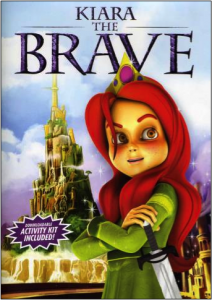It’s summer 2012 and you’re in the supermarket checkout line. You see a DVD for a new animated film. A courageous red-headed princess from a far-away kingdom goes on a magical journey to save her parents. You’ve heard of this film – ah yes that’s it: Brave… Kiara the Brave, not the Pixar film but the ‘mockbuster’ complete with ‘Downloadable Activity Kit.’
The mockbuster, coinciding with a major studio release, is a longstanding phenomenon in the animation industry, but one that has gained media prominence with the rise of online distribution. The Daily Mail is particularly scathing, accusing distributors of: “Preying on confusion” (The Mail Online, 25 June 2012). According to the Los Angeles Times: “Imitation has been the sincerest form of flattery since the earliest days of Hollywood,” but here it leaves consumers feeling cheated (Fritz, Ben. Los Angeles Times, 24 June 2012). However there is more to Kiara the Brave than meets the eye.
Seven months before Brave, Shemaroo Entertainment released its own fantasy film Super K: (Trailer 2:33). The viewer is presented with animated fantasy, populated by super-hero characters, a battle between good and evil in which the ‘strong boy’ Super Kloud must learn to fulfill his destiny. Those familiar with Indian animation may recognize recurring motifs, but the film’s promotional materials enlighten us, not only about the film, but how it fits into a trajectory of industrial development. The Indian animation trade press highlights contributions to the growth of its industry: such as innovative online-only distribution targeting a vibrant new media marketplace. News of this strategy traveled widely, including coverage outside of India: “Indian Animated Film ‘Super K’ to Debut Online Ahead of Theatrical Release” (Chris Arrant, Cartoon Brew. 17 Oct. 2011). More than hype, this reveals a wider discourse within the Indian industry, moving from animation as commodity to recognizable brands and associations. As producer Smita Maroo explains:
“Partnering with brands which belong to the animation ecosystem is not just about the number of eyeballs that the association brings to the film, but also about creating solidarity and working relationships across the value chain” – (Anand Gurnani, AnimationXpress, 10 Nov. 2011)
International distribution forms a key part of this strategy. However in June 2012 when Canadian distributor Phase 4 Films released the film in North America, Super K retained neither its producer narratives nor Indian-based brand identity.
Still, the dramatic rebranding of Super K as Kiara the Brave is startling: (Trailer 0:42). Super Kloud himself is supplanted by supporting character Princess Kiara. Nothing has happened to the film itself, but all the surrounding materials have changed. Instead of extending its own identity, an existing one is ‘borrowed’. The same technologies Shemaroo leveraged to create its brand identity, here work against them. In the face of a threatened dominant brand, the narrative of innovations put forward by the Indian trade press is entirely absent. With such brand conflict, memories are decidedly short. A year after hailing Shemaroo’s original release, the Cartoon Brew post “Meet India’s Answer to Brave Called ‘Kiara the Brave’” adopts a starkly different tone: “The synopsis is so stupid that it’s not even worth reprinting. Just enjoy the trailer.” (Amid Amidi, Cartoon Brew. 14 June, 2012) Here promotional materials are re-consumed, subject to humor and scorn.
Super K is not an imitation of Brave. However the promotional construct Kiara the Brave certainly is, even if the only similarities are Phase 4’s marketing. Regardless, the film is exposed as a case study on the stakes of promotions across industrial contexts and the consequences in shaping international brand identity. Super K was marketed a year before the release of Brave. However the contrived association is potentially damaging to the evolving and emerging branding of Indian animation. The conflict between brand identities, as cultural objects, reduces space for emerging cultural commodities to hide. Super K is in many ways a good example of practices many Indian animators wish to promote and build upon. However in enacting this progression, India’s animation practitioners face a changing relationship with global industry. If such trends continue, it is likely that an internationally recognized brand for Indian animation will emerge, but it will not be that currently favored by the Indian animation community.
References:
Amidi, Amid. “Meet India’s Answer to Brave Called ‘Kiara the Brave’” Cartoon Brew. 14 June, 2012. http://www.cartoonbrew.com/cgi/meet-indias-answer-to-brave-called-kiara-the-brave-64727.html Accessed 8 Oct. 2012.
Arrant, Chris. “Indian Animated Film ‘Super K’ to Debut Online Ahead of Theatrical Release” Cartoon Brew. 17 Oct. 2011, http://www.cartoonbrew.com/biz/indian-animated-film-super-k-to-debut-online-ahead-of-theatrical-release-51423.html Accessed 18 Oct. 2012.
Fritz, Ben. “Low-budget knockoff movies benefit from Hollywood blockbusters” Los Angeles Times, 24 June 2012. http://articles.latimes.com/2012/jun/24/business/la-fi-ct-knock-offs-20120624 Accessed 8 Oct. 2012
Gurnani, Anand. “Partnerships Across the Value Chain: Shemaroo Now Ties up with Zee Institute of Creative Arts for Super K” Animation Xpress, 10 Nov. 2011. http://www.animationxpress.com/index.php/latest-news/partnerships-across-the-value-chain-shemaroo-now-ties-up-with-zee-institute-of-creative-arts-for-super-k-2 Accessed 18 Oct. 2012
“Inside the bizarre world of ‘knock-off’ movies which ‘try to confuse viewers looking for Hollywood blockbusters’” The Mail Online 25 June 2012, http://www.dailymail.co.uk/news/article-2164290/Inside-world-knock-mockbuster-movies-try-confuse-viewers.html Accessed 8 Oct. 2012.
Phase 4 Films “Kiara the Brave: Product Fact Sheet” http://www.phase4films.com/detail.aspx?projectId=68cfaf9a-1ff2-4d4d-e724-a7aa9dafce08 Accessed 1 Nov. 2012.
Timothy Jones is a PhD candidate in the School of Film, Television and Media Studies at the University of East Anglia (UEA). His current research investigates how Indian animation filmmakers represent their practice and the impact this has upon professional and community structures. Wider interests include both educational development and animation archives. He joined UEA from the University of Southern California (USC) Institute for Creative Technologies (ICT) in Los Angeles, where he developed award-winning instructional simulations and serious games applying immersive motion graphics. Timothy is an active member of the Society for Animation Studies and a managing editor of the society’s journal.


